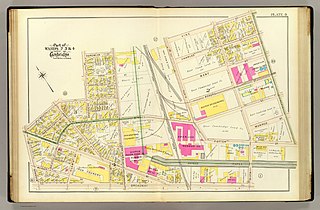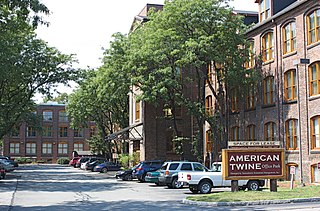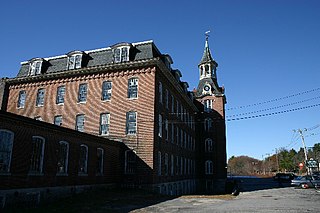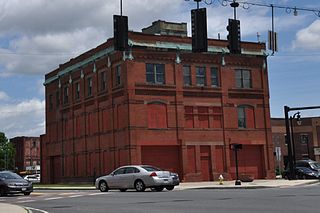
Kendall Square is a neighborhood in Cambridge, Massachusetts, United States. The square itself is at the intersection of Main Street and Broadway. It also refers to the broad business district east of Portland Street, northwest of the Charles River, north of MIT and south of Binney Street.

The Lowertown Historic District is a historic district in the Lowertown neighborhood of Saint Paul, Minnesota, United States. This 16-block warehouse and wholesaling district comprises 37 contributing properties built 1870s–1920. It was listed on the National Register of Historic Places in 1983 for the significance of its river and rail connections, economic impact, architecture, and urban planning. Lowertown was originally the lower landing on the Mississippi River; the first port of access to the Twin Cities. Several warehouse, railroad, banking, and distribution buildings served the entire Upper Midwest from 1880 to 1920. A significant concentration of these buildings survive, unified by similar architectural styles and construction materials. Many were designed by the city's most prestigious architects, including Cass Gilbert and Clarence H. Johnston Sr.

The American Net and Twine Company Factory is a historic factory at 155 2nd Street in Cambridge, Massachusetts. It was built in 1875 by the nation's first manufacturer of cotton fishing nets. It now houses corporate office space. It was listed on the National Register of Historic Places in 1982.

The East Cambridge Historic District encompasses the historic center of East Cambridge, Massachusetts. It includes the major buildings that were built to house county services for Middlesex County beginning in the 1810s, and a cluster of largely vernacular Greek Revival worker housing located west of the county complex on Otis, Thorndike, Spring, and Sciarappa Streets. The district was listed on the National Register of Historic Places in 1983.

The Linwood Historic District is an industrial historic district in the Linwood village of Northbridge, Massachusetts. It is the site of the Linwood Cotton Mill and is roughly bounded by Linwood Avenue, Maple Court, and Pine Court. On June 16, 1989, it was added to the National Register of Historic Places.

The South Worthington Historic District is a historic district encompassing the formerly industrial, but now rural, village of South Worthington, Massachusetts. The village is centered on the junction of Huntington Road, Ireland Street, and Thrasher Hill Road. The district extends along Ireland Road as far as Conwell Road, and one contributing element, the dam which impounds Little Galilee Pond, extends into neighboring Chesterfield. The area had a number of small mills along the banks of the Little River, a tributary of the Westfield River, but only one complex, the Theron Higgins Mill on South Worthington Road, has survived from the 19th century. Most of the buildings in the district are residences dating to the 19th century; also included are three churches, including the particularly elegant Greek Revival South Worthington Methodist Church (1848). The district was added to the National Register of Historic Places in 2005.

Winchester Square Historic District is a historic district encompassing a cluster of brick buildings at and near the intersection of State Street and Wilbraham Road on the east side of Springfield, Massachusetts. The buildings, most of which were built for industrial purposes, are clustered on five parcels, and were built between 1875 and 1913. It includes the Armory railroad station (1875), the Winchester Square fire station, the Knox Automobile Company buildings (1891-1910), and the Indian Motorcycle Company plant, part of which later became the Springfield Industrial Institute complex. The district was listed on the National Register of Historic Places in 1979.

The Kennedy-Worthington Blocks are three historic commercial and industrial buildings at 1585-1623 Main Street and 166-190 Worthington Street in downtown Springfield, Massachusetts. Built in the 1870s and 1880s, with a major restyling to two of them in 1912, the buildings were a major factor in the urban development of the area north of the city's traditional core. They were listed to the National Register of Historic Places in 1979.

The Springfield Steam Power Company Block is a historic industrial building at 51-59 Taylor Street in downtown Springfield, Massachusetts. Built in 1881, it is a surviving example of a late 19th-century power distribution component, part of a scheme by the Springfield Steam Power Company to deliver steam power to nearby industrial facilities. The block was listed on the National Register of Historic Places in 1983. Its ground floor now houses "The City Church", a local community of Jesus followers.

The North Canal Historic District of Lawrence, Massachusetts, encompasses the historic industrial heart of the city. It is centered on the North Canal and the Great Stone Dam, which provided the waterpower for its many mill complexes. The canal was listed on the National Register of Historic Places in 1975, while the district was first listed in 1984, and then expanded slightly in 2009.

The Arlington Pumping Station, built in 1907, is a historic water pumping station on Brattle Court in Arlington, Massachusetts. Its purpose was to provide water to Lexington and higher elevations in Arlington. The station was put in service on December 4, 1907.

The American Waltham Watch Company Historic District encompasses the former factory of the Waltham Watch Company, the leading American watch manufacturer of the 19th century and the city's largest employer. Located on Crescent Street and the banks of the Charles River, the surviving elements of its manufacturing facility date from the 1870s to the 1910s, and include particularly fine industrial Romanesque architecture. The buildings have been converted to a variety of commercial, industrial and residential uses since they ceased being used for watchmaking in the 1950s. The complex was listed on the National Register of Historic Places in 1989.

The Crompton Loom Works is an historic industrial complex of the Crompton Corporation at 132-142 Green Street in Worcester, Massachusetts. The factory manufactured looms for textile factories. With its original portion dating to 1860, the complex is one of the oldest surviving industrial sites in the city. The facility was established by George Crompton, whose father William had invented the first power loom for weaving fancy fabrics. The younger Crompton's business would become of the most significant employers in the city, and his innovative looms would revolutionize the textile industry. Crompton and his successors would operate the loom manufacturing works at Green Street well into the 1960s. The manufacturing capabilities on the site were applied to producing can packaging machines and bowling pinsetters. Capabilities at the Green Street facility included machining, drop hammer forging, a cast iron foundry, wood working. and pattern making, along with a materials testing lab.. The building has subsequently been adapted to other uses. The complex was listed on the National Register of Historic Places in 1980, and included as part of the Blackstone Canal Historic District in 1995.

The Harding-Winter Street Manufacturing District encompasses a surviving fragment of the 19th century industrial history of Worcester, Massachusetts. The district includes seven brick factory buildings which were built between 1870 and 1898. They are a remnant of a once-extensive manufacturing district that extended further along Franklin and Grafton Streets, but has become fragmented by urban redevelopment and the construction of nearby Interstate 290. The district is bounded on the south by Pond Street, on the west by Harding Street, on the east by Water Street, and on the north by the rear property lines of Winter Street properties. The district was listed on the National Register of Historic Places in 1980.

The Junction Shop and Hermon Street District is a historic district comprising 28 industrial properties on Jackson, Hermon, and Beacon Streets on the south side of Worcester, Massachusetts. It is a remnant of a once larger 19th and early 20th century manufacturing district just west of the railway junction between the Boston and Maine Railroad and the New York, New Haven and Hartford Railroad. It was listed on the National Register of Historic Places in 1980.

Kendall Boiler and Tank Company Building is a one-story commercial edifice located on 275 Third Street in Kendall Square, Cambridge, Massachusetts. The brick building was formerly owned by the Kendall Boiler and Tank Company and is part of the Blake and Knowles Steam Pump Company National Register District, on the National Register of Historic Places.

The Worthington Corporation was a diversified American manufacturer that had its roots in Worthington and Baker, a steam pump manufacturer founded in 1845. In 1967 it merged with Studebaker and Wagner Electric to form Studebaker-Worthington. This company was in turn acquired by McGraw-Edison in 1979.

The Nashua Gummed and Coated Paper Company Historic District encompasses a collection of former industrial buildings on the north side of the Nashua River in Nashua, New Hampshire. Located on Franklin and Front Streets west of Main Street, the complex was developed by the Nashua Gummed and Coated Paper Company, later the Nashua Corporation, beginning in the late 19th century. It was a major manufacturing and employment center for the city until mid-1990s, when the company's business declined. One of its former storehouses was converted to residences in the 2000s, and the main complex is, in 2015-16, undergoing the same process. The complex of surviving buildings was listed on the National Register of Historic Places in 2015.

The George Close Company Building is a historic industrial building at 243 Broadway in Cambridge, Massachusetts. Built in 1910 for a candy manufacturer, it is a good local example of industrial Classical Revival architecture and was converted to residential use in 1976. The building was added to the National Register of Historic Places in 2019.

The American Optical Company Historic District encompasses a historic industrial complex on the Quinebaug River in Southbridge, Massachusetts. Located on roughly 80 acres (32 ha) east of downtown Southbridge, the complex was developed between the 1880s and 1950s by the American Optical Company (AO), one of the largest manufacturers of eyewear at the turn of the 20th century. The district was listed on the National Register of Historic Places in 2023.























